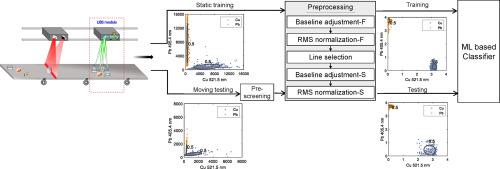Spectrochimica Acta Part B: Atomic Spectroscopy ( IF 3.2 ) Pub Date : 2021-09-13 , DOI: 10.1016/j.sab.2021.106282 Hyebin Kim 1 , Jaepil Lee 2 , Ekta Srivastava 1 , Sungho Shin 3 , Sungho Jeong 2 , Euiseok Hwang 1, 4

|
In this study, a front-end signal processing scheme is proposed for classifying spectra of metal scraps via laser-induced breakdown spectroscopy (LIBS), particularly for high-speed sorting systems dealing with moving samples. LIBS can provide an accurate and efficient classification of unknown samples without complex sample preparation steps by employing machine learning (ML) techniques, indicating its good potential for various real-time industrial applications, including medicine and environmental science. Thus, LIBS systems are being actively studied to develop high-speed metal scrap recycling systems integrated with conveyor belts. However, preprocessing LIBS-captured spectra before applying ML is critical to ensure robust operation in dynamic environments caused by the movement of arbitrarily shaped samples with different surface contamination acquired in the industrial field. To mitigate the effect of such noise and disturbances during model training, the proposed scheme uses a large amount of spectra collected from static samples to train ML models. In the case of actual-moving test samples, prescreening is used to detect undesired spectra, such as noise dominated ones caused by incorrectly addressed laser beam on a target sample, where the standard deviation of low-intensity spectral lines is used as a test statistic. Then, valid spectrum is sequentially preprocessed via baseline removal (BR) and root-mean-square-based normalization (BR-RMSN) in two stages, with the broadband spectrum and finite informative emission lines, resulting in a total of five preprocessing steps, which effectively compensate for the potentially large fluctuations observed under dynamic conditions. For evaluations, field samples of five representative metal types, including aluminum, copper, stainless steel, lead, and zinc, are experimented at different times using a LIBS-based high-speed sorting system and processed via the static-sample training and moving-sample testing scenarios. Experimental results show that the proposed prescreening method can detect outlier spectra with an accuracy of 99.0%, which is an improvement from 95.2% of the conventional partial least-squares discriminant analysis (PLS-DA) scheme; the information-theoretic distance between static and moving samples in different times can be effectively reduced using the proposed two-stage BR-RMSN, resulting in a classification accuracy greater than 95.5% for all five metal types, which is a significant improvement compared to 91.2% accuracy obtained without preprocessing.
中文翻译:

基于激光诱导击穿光谱的在线测量金属废料分类前端信号处理
在这项研究中,提出了一种前端信号处理方案,用于通过激光诱导击穿光谱 (LIBS) 对金属废料的光谱进行分类,特别是对于处理移动样品的高速分拣系统。通过采用机器学习 (ML) 技术,LIBS 无需复杂的样品制备步骤即可对未知样品进行准确有效的分类,这表明其在各种实时工业应用(包括医学和环境科学)中具有良好的潜力。因此,正在积极研究 LIBS 系统,以开发与传送带集成的高速金属废料回收系统。然而,在应用 ML 之前预处理 LIBS 捕获的光谱对于确保在工业领域中获得的具有不同表面污染的任意形状样品的移动引起的动态环境中的稳健运行至关重要。为了减轻模型训练过程中此类噪声和干扰的影响,所提出的方案使用从静态样本中收集的大量频谱来训练 ML 模型。在实际移动的测试样品的情况下,预筛选用于检测不需要的光谱,例如由于目标样品上的错误寻址激光束引起的噪声占主导地位的光谱,其中低强度谱线的标准偏差用作测试统计量. 然后,通过基线去除(BR)和基于均方根归一化(BR-RMSN)两个阶段对有效频谱进行顺序预处理,使用宽带光谱和有限的信息发射线,总共有五个预处理步骤,有效地补偿了在动态条件下观察到的潜在大波动。对于评估,使用基于 LIBS 的高速分选系统在不同时间对五种代表性金属类型(包括铝、铜、不锈钢、铅和锌)的现场样品进行试验,并通过静态样品训练和移动处理进行处理。示例测试场景。实验结果表明,所提出的预筛选方法能够以99.0%的准确率检测离群光谱,比传统的偏最小二乘判别分析(PLS-DA)方案的95.2%有了改进;











































 京公网安备 11010802027423号
京公网安备 11010802027423号